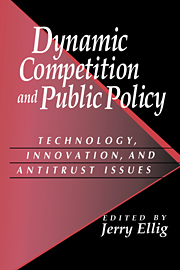Book contents
- Frontmatter
- Contents
- List of Figures and Tables
- Acknowledgments
- List of Contributors
- Introduction
- 1 A Taxonomy of Dynamic Competition Theories
- 2 Competence Explanations of Economic Profits in Strategic Management: Some Policy Implications
- 3 Innovation and Antitrust Enforcement
- 4 New Indicia for Antitrust Analysis in Markets Experiencing Rapid Innovation
- 5 Innovation and Monopoly Leveraging
- 6 Network Effects and the Microsoft Case
- 7 Technological Standards, Innovation, and Essential Facilities: Toward a Schumpeterian Post-Chicago Approach
- 8 Intellectual Property and Antitrust Limitations on Contract
- 9 Conclusion
- Index
1 - A Taxonomy of Dynamic Competition Theories
Published online by Cambridge University Press: 05 June 2012
- Frontmatter
- Contents
- List of Figures and Tables
- Acknowledgments
- List of Contributors
- Introduction
- 1 A Taxonomy of Dynamic Competition Theories
- 2 Competence Explanations of Economic Profits in Strategic Management: Some Policy Implications
- 3 Innovation and Antitrust Enforcement
- 4 New Indicia for Antitrust Analysis in Markets Experiencing Rapid Innovation
- 5 Innovation and Monopoly Leveraging
- 6 Network Effects and the Microsoft Case
- 7 Technological Standards, Innovation, and Essential Facilities: Toward a Schumpeterian Post-Chicago Approach
- 8 Intellectual Property and Antitrust Limitations on Contract
- 9 Conclusion
- Index
Summary
Exactly what is dynamic competition, anyway?
Scholars offer a number of answers to that question, and there is no consensus on which theory of dynamic competition is the most accurate or useful. To underscore the diverse intellectual currents that flow through this volume, our initial chapter offers short synopses of the principal dynamic theories of competition.
By far the most prominent dynamic theory of competition is associated with Joseph Schumpeter. Although Schumpeter did not deny that real-world markets can resemble the perfectly competitive model, he argued that the most significant advances in human well-being come from forms of competition that involve new products, new technologies, new sources of supply, and new forms of business organization.
In addition to Schumpeter, other scholars have also developed dynamic theories of competition. “Evolutionary” competition theorists are perhaps Schumpeter's best-known modern descendants. Some of Schumpeter's fellow Austrian economists developed complementary theories that emphasize competition as a process for the discovery of new knowledge. More recently, the interaction of competition and technological change has prompted interest in theories of path dependence, in which small variations in initial conditions can lead to large and unpredictable changes in the market's evolution. Finally – and less well known in the economics profession – are strategic management theories that explicitly view competition as a dynamic process.
- Type
- Chapter
- Information
- Dynamic Competition and Public PolicyTechnology, Innovation, and Antitrust Issues, pp. 16 - 44Publisher: Cambridge University PressPrint publication year: 2001
- 10
- Cited by

